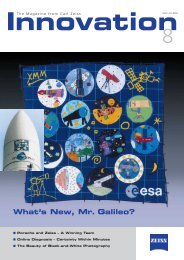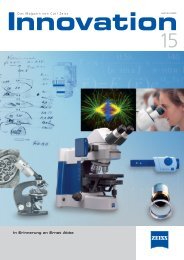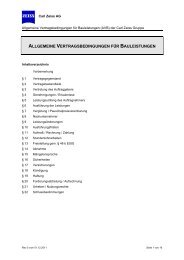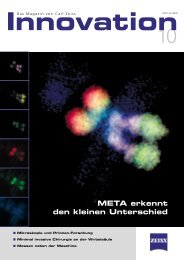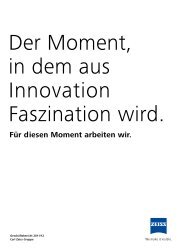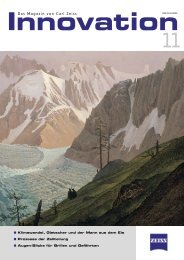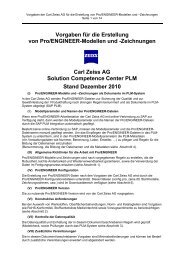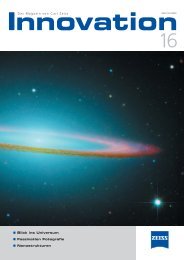Download PDF - Carl Zeiss
Download PDF - Carl Zeiss
Download PDF - Carl Zeiss
You also want an ePaper? Increase the reach of your titles
YUMPU automatically turns print PDFs into web optimized ePapers that Google loves.
ography<br />
EBID – innovative<br />
nanostructuring<br />
technology<br />
Experiments in size-reducing electron<br />
projection (Tübingen in 1971, Darmstadt<br />
in 1984) made it clear that the<br />
desired high resolution in electron<br />
beam lithography could only be<br />
achieved with a loss of sensitivity of<br />
the registration procedure. The highest<br />
resolution can be achieved when<br />
small molecules are used for registration<br />
by means of direct metallization<br />
deposition. The EBID (Electron Beam<br />
Induced Deposition) nanostructuring<br />
technology involves directing a jet of<br />
organo-metallic molecules onto the<br />
substrate in a vacuum. The molecules<br />
adsorbed in the substrate are then<br />
decomposed by an electron beam<br />
that is focused to a diameter of just a<br />
few nanometers, thus delivering an<br />
energy density of up to 2 MW/cm 2 .<br />
Organometallic<br />
molecules<br />
or etching<br />
gas<br />
Evaporating<br />
radicals<br />
Innovation 16, <strong>Carl</strong> <strong>Zeiss</strong> AG, 2005<br />
Jet<br />
Mask<br />
Within a few minutes, 3-dimensional<br />
deposition products then grow from<br />
the molecular fragments and atoms.<br />
Since molecules are used individually,<br />
the procedure is 1 million times slower<br />
than conventional resist electron<br />
beam lithography.<br />
Nanostructuring was studied by<br />
means of direct-write using single<br />
beam lithography at the IBM T. J.<br />
Watson Research Center in the USA,<br />
and by electron shadow projection<br />
and size-reducing electron projection<br />
at the Technical University of Darmstadt,<br />
Germany. The technique of<br />
electron shadow projection has since<br />
become known as EPL (Electron Projection<br />
Lithography). Other fundamental<br />
investigations and initial applications,<br />
such as single beam deposition<br />
and etching procedures, were<br />
carried out at the Deutsche Telekom<br />
Research Center, FTZ.<br />
Electron beam<br />
Etch dip<br />
Residual gas<br />
Deposit Adsorbed<br />
molecules<br />
2<br />
special<br />
Rapid prototyping<br />
using EBID<br />
Rapid prototyping procedures are<br />
fabrication processes used to directly<br />
and rapidly implement existing<br />
design data to produce workpieces<br />
with as little manual handling as<br />
possible. The procedures that have<br />
become known as rapid prototyping<br />
since the 1980s are usually master<br />
molding methods that use physical<br />
and/or chemical effects to build<br />
up the workpiece in layers from<br />
materials that have no shape or are<br />
neutral in shape.<br />
Starting in the fall of 1997, a<br />
research team at Deutsche Telekom<br />
AG commissioned by USA-based<br />
Corning Inc. developed a rapid<br />
prototyping technology for spectral<br />
filters based on photonic crystals.<br />
Photonic crystals are 3-dimensional,<br />
periodical, dielectric structures built<br />
up using the EBID technique which<br />
consist of rods with diameters of 1/5<br />
of the wavelength that are arranged<br />
at a distance of 1/3 of the wavelength<br />
from each other. A PC filter<br />
for infrared light with a wavelength<br />
of 1.5 µm such as used in telecommunications<br />
needs to consist of<br />
approx. eighty 0.3 µm x 2 µm rods<br />
that are spaced at 0.5 µm intervals<br />
and made of a material with the<br />
highest possible refractive index<br />
(n > 2.8). The team developed and<br />
patented the production of photonic<br />
crystals (PC) and other miniaturized<br />
planar optical components using<br />
EBID technology. Spectral filters<br />
(3 µm x 3 µm) were fabricated in as<br />
little as 40 minutes and proved to<br />
have nanometer precision in waveguide<br />
measuring structures.<br />
47




